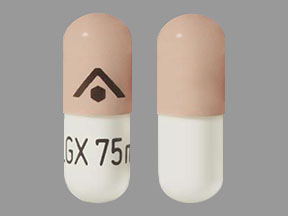Braftovi Dosage
Generic name: ENCORAFENIB 75mg
Dosage form: capsule
Drug class: Multikinase inhibitors
Medically reviewed by Drugs.com. Last updated on Jul 24, 2025.
Patient Selection
BRAF V600E or V600K Mutation-Positive Unresectable or Metastatic Melanoma
Confirm the presence of a BRAF V600E or V600K mutation in tumor specimens prior to initiating BRAFTOVI or in combination with weekly cetuximab until disease progression or unacceptable toxicity.
Administration
BRAFTOVI may be taken with or without food. Do not take a missed dose of BRAFTOVI within 12 hours of the next dose of BRAFTOVI.
Do not take an additional dose if vomiting occurs after BRAFTOVI administration but continue with the next scheduled dose.
Dosage Modifications for Adverse Reactions
BRAF V600E or V600K Mutation-Positive Unresectable or Metastatic Melanoma or BRAF V600E Mutation-Positive Metastatic NSCLC
If binimetinib is withheld, reduce BRAFTOVI to a maximum dose of 300 mg (four 75 mg capsules) once daily until binimetinib is resumed.
Dose reductions for adverse reactions associated with BRAFTOVI are presented in Table 1.
Table 1: Recommended Dose Reductions for BRAFTOVI for Adverse Reactions – Melanoma or NSCLC
|
Action |
Recommended Dose |
|
First Dose Reduction |
300 mg (four 75 mg capsules) orally once daily |
|
Second Dose Reduction |
225 mg (three 75 mg capsules) orally once daily |
|
Subsequent Modification |
Permanently discontinue if unable to tolerate BRAFTOVI 225 mg (three 75 mg capsules) once daily |
BRAF V600E Mutation-Positive Metastatic Colorectal Cancer (CRC)
If cetuximab is discontinued, discontinue BRAFTOVI.
Dose reductions for adverse reactions associated with BRAFTOVI are presented in Table 2.
|
Action |
Recommended Dose |
|
First Dose Reduction |
225 mg (three 75 mg capsules) orally once daily |
|
Second Dose Reduction |
150 mg (two 75 mg capsules) orally once daily |
|
Subsequent Modification |
Permanently discontinue if unable to tolerate BRAFTOVI 150 mg (two 75 mg capsules) once daily |
BRAF V600E or V600K Mutation-Positive Unresectable or Metastatic Melanoma, BRAF V600E Mutation-Positive Metastatic Colorectal Cancer (CRC), or BRAF V600E Mutation-Positive NSCLC
Dosage modifications for adverse reactions associated with BRAFTOVI are presented in Table 3.
| Severity of Adverse Reaction* | Dose Modification for BRAFTOVI |
|---|---|
|
|
|
New Primary Malignancies |
|
|
Noncutaneous RAS Mutation-positive Malignancies |
Permanently discontinue BRAFTOVI. |
|
Cardiomyopathy |
|
|
Reduce BRAFTOVI by one dose level.
|
|
Hepatotoxicity |
|
|
Maintain BRAFTOVI dose.
|
|
|
|
Uveitis |
|
|
If Grade 1 or 2 does not respond to specific ocular therapy, or for Grade 3 uveitis, withhold BRAFTOVI for up to 6 weeks.
|
|
Permanently discontinue BRAFTOVI. |
|
QTc Prolongation |
|
|
Withhold BRAFTOVI until QTcF less than or equal to 500 ms. Resume at reduced dose.
|
|
Permanently discontinue BRAFTOVI. |
|
Dermatologic [other than Hand-foot Skin Reaction (HFSR)] |
|
|
If no improvement within 2 weeks, withhold BRAFTOVI until Grade 0–1. Resume at same dose. |
|
Withhold BRAFTOVI until Grade 0–1. Resume at same dose if first occurrence or reduce dose if recurrent. |
|
Permanently discontinue BRAFTOVI. |
|
Other Adverse Reactions (including Hemorrhage) and HFSR† |
|
|
Withhold BRAFTOVI for up to 4 weeks.
|
|
Permanently discontinue BRAFTOVI or
|
|
Consider permanently discontinuing BRAFTOVI. |
|
Permanently discontinue BRAFTOVI. |
Refer to the binimetinib or cetuximab prescribing information for dose modifications for adverse reactions associated with each product, as appropriate.
Dose Modifications for Coadministration with Strong or Moderate CYP3A4 Inhibitors
Avoid coadministration of BRAFTOVI with strong or moderate CYP3A4 inhibitors. If coadministration is unavoidable, reduce the BRAFTOVI dose according to the recommendations in Table 4. After the inhibitor has been discontinued for 3 to 5 elimination half-lives, resume the BRAFTOVI dose that was taken prior to initiating the CYP3A4 inhibitor.
|
||
|
Current Daily Dose* |
Dose for Coadministration with Moderate CYP3A4 Inhibitor |
Dose for Coadministration with Strong CYP3A4 Inhibitor |
|
450 mg |
225 mg (three 75 mg capsules) |
150 mg (two 75 mg capsules) |
|
300 mg |
150 mg (two 75 mg capsules) |
75 mg |
|
225 mg |
75 mg |
75 mg |
|
150 mg |
75 mg |
75 mg† |
Frequently asked questions
More about Braftovi (encorafenib)
- Check interactions
- Compare alternatives
- Pricing & coupons
- Reviews (1)
- Drug images
- Side effects
- During pregnancy
- FDA approval history
- Drug class: multikinase inhibitors
- Breastfeeding
- En español
Patient resources
Professional resources
Related treatment guides
See also:
Further information
Always consult your healthcare provider to ensure the information displayed on this page applies to your personal circumstances.


